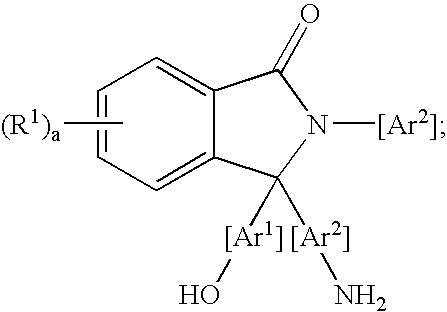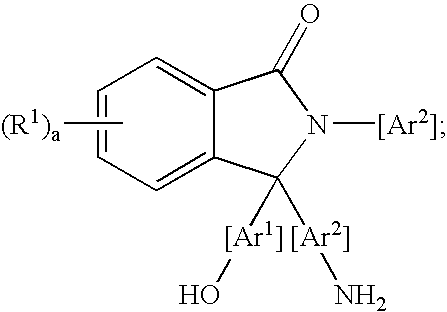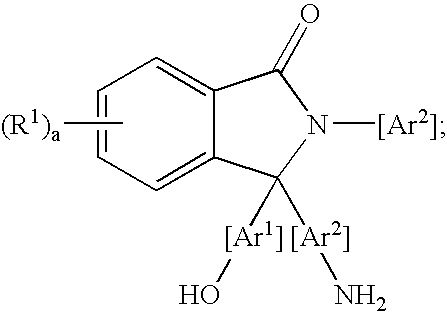Methods for purifying 2-aryl-3,3-bis(hydroxyaryl)phthalimidines
a technology of hydroxyarylphthalimidine and phthalimidine, which is applied in the field of purification of 2aryl3′, 3bis (hydroxyaryl)phthalimidine, can solve the problems of increased brittleness, para-pppbp having undesirable physical properties to the resulting polymer, and color and purity that cannot be used as monomers or comonomers
- Summary
- Abstract
- Description
- Claims
- Application Information
AI Technical Summary
Benefits of technology
Problems solved by technology
Method used
Image
Examples
example 1
Preparation of Para, Para-PPPBP
[0100] In a 500 milliliter four neck round bottom flask fitted with a overhead stirrer, a nitrogen gas inlet, thermo-well, and a condenser fitted with a Dean-Stark apparatus were placed 100 grams (0.3141 mole) of phenolphthalein, 117 grams (1.25 mole) of aniline, and 32.8 milliliters of 35% aqueous HCl (0.3141 mole). A slow stream of nitrogen gas was continuously passed through the flask, and the reaction mixture was heated at 100 to 120° C. for 2 to 3 hours to remove the water. After approximately 21 milliliters of water had been collected, the hot reaction mixture was heated at 155 to 160° C. for 22 to 24 hours. Then the reaction mixture was cooled to 100 to 110° C., 250 milliliters of 10% aqueous HCl was poured into the reaction mass, and the resulting mixture was stirred for about 2 hours. The precipitate formed was filtered out, washed with water (5×100 milliliters) until the washings were free of acid, and dried to furnish crude PPPBP product. T...
examples 13 to 15
[0104] These Examples illustrate the general procedure for removing the AP impurity from a para, para-PPPBP feed by using phthalic anhydride as an organic anhydride.
[0105] A sample of impure para, para-PPPBP (5 grams) was treated with 30 milliliters of ortho-dichlorobenzene, treated with a calculated amount of phthalic anhydride, and refluxed for about 4 hours. Then the solution was cooled to ambient temperature, filtered, and washed with ortho-dichlorobenzene. Results are shown in
TABLE 2Weight ratio ofExampleOrganicorganic anhydrideAP levelnumberanhydrideto feed PPPBPSolvent system(ppm)Control-2nonenone314213Phthalic1:0.06Ortho100anhydridedichlorobenzene14Phthalic1:0.03Ortho120anhydridedichlorobenzene15Phthalic 1:0.006Ortho680anhydridedichlorobenzene
[0106] Table 3 shows that when the amount of phthalic anhydride relative to para, para-PPPBP feed is reduced, the AP impurity level increases.
examples 19 and 20
, and Comparative Examples 5 and 6
[0110] These examples illustrate the effect of temperature on the ability of the acidic material to remove the AP impurity from a feed para, para-PPPBP material having 3570 ppm of AP as impurity. The process was studied by treating a solution of para, para-PPPBP feed in 20 volumes of 90:10 isopropanol / water, respectively with Lewatit K1131 ion exchange resin in a batch process at temperatures ranging from ambient to 70° C. Results are shown in Table 4, where the values represent ppm of AP in the treated para, para-PPPBP after the indicated time. “ND” stands for “not detected”, which means the value is below the detection limit (less than 10 ppm) of the HPLC instrument. “NA” stands for “not applicable”.
TABLE 4ComparativeComparativeTreatmentExample 20Example 5Example 6timeAmbient Temperature(hours)Example 1950° C.60° C.70° C.03570 3570 35703570 1NDND30301224ND542793251977278425411553205NA441253576NA42190NA
[0111] Table 4 shows that as the temperature...
PUM
| Property | Measurement | Unit |
|---|---|---|
| yellowness index | aaaaa | aaaaa |
| molecular weight | aaaaa | aaaaa |
| period of time | aaaaa | aaaaa |
Abstract
Description
Claims
Application Information
 Login to View More
Login to View More - R&D
- Intellectual Property
- Life Sciences
- Materials
- Tech Scout
- Unparalleled Data Quality
- Higher Quality Content
- 60% Fewer Hallucinations
Browse by: Latest US Patents, China's latest patents, Technical Efficacy Thesaurus, Application Domain, Technology Topic, Popular Technical Reports.
© 2025 PatSnap. All rights reserved.Legal|Privacy policy|Modern Slavery Act Transparency Statement|Sitemap|About US| Contact US: help@patsnap.com



